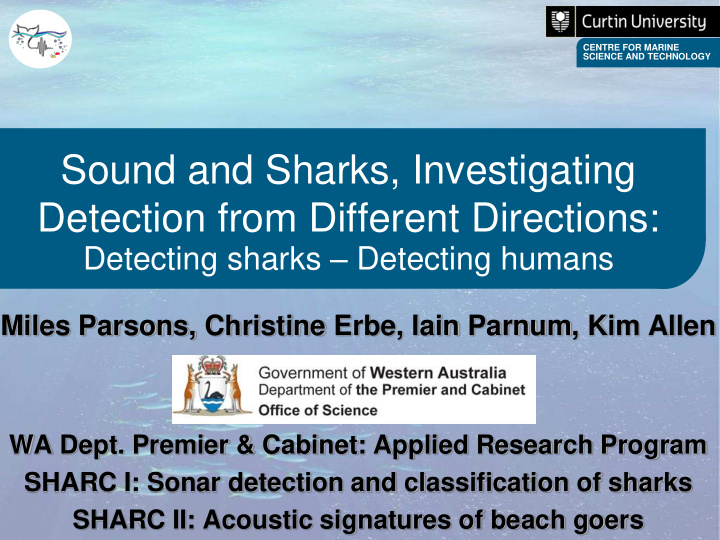



CENTRE FOR MARINE CENTRE FOR MARINE SCIENCE AND TECHNOLOGY SCIENCE AND TECHNOLOGY Sound and Sharks, Investigating Detection from Different Directions: Detecting sharks – Detecting humans Miles Parsons, Christine Erbe, Iain Parnum, Kim Allen WA Dept. Premier & Cabinet: Applied Research Program SHARC I: Sonar detection and classification of sharks SHARC II: Acoustic signatures of beach goers
Background to this work CENTRE FOR MARINE SCIENCE AND TECHNOLOGY • 2012 – Several encounters and fatalities prompted WA Government (Applied Research Program) funding “SHARC” • 2013 – CMST with Mullaloo (MSLSC) members awarded research grant: Feasibility of shallow water sonar shark detection. If a suitable system existed, develop algorithms to detect sharks Estimate potential environmental impact. • – MSLSC acoustic tag receiver array to detect tagged sharks 2014 – Curtin/MSLSC initiate MOU “ BeachLAB ” as a platform to scientifically test Beach Safety Management Technologies (Initially shark orientated) - CMST with Mullaloo (MSLSC) members awarded SHARC II grant: Characterise acoustic signatures of water-based activities as a potential cue for sharks • 2016 –“SHARC” project outcomes Current systems limited range in shallow water Laid out specifications for ‘optimum’ shark detection sonar Laid out experimental procedures to test performance and impact • 2017 – Seeking funding to progress this (discussions Shark Mitigation Systems)
Overview: Two Projects CENTRE FOR MARINE SCIENCE AND TECHNOLOGY • Acoustic signatures of beach goers as a potential cue for sharks: Characterise sounds produced by humans during different water-based activities and assess if they may be detected by sharks. – Background (sound pressure, particle motion and fauna hearing ) – Typical coastal underwater sounds (mechanical) – Human-powered activities (swimming, kayaking, diving) – Playback tests • Sonar detection and identification of sharks: Assess feasibility of using sonar to detect sharks using off-the-shelf systems. If so, develop detection algorithms and assess the likely environmental impact • Brief history of sonar and sharks • Initial studies in 2013, short range detection • Shark Bay tests • Environmental impact
Take home message: Sound cues CENTRE FOR MARINE SCIENCE AND TECHNOLOGY • Quantifying human signals and contribution to the local soundscape is relatively simple. • Human-powered signals are audible, considerably quieter than mechanical noise, likely audible over tens of metres. o Useful for evaluating swimmers performance • Signals are complex, as would be masking them. o Highly variable (35-40 dB variation between 5 th and 95 th %iles) • Accurately quantifying sound pressure and particle velocity in confined spaces is complex and varies considerably with frequency – Requires significant knowledge of acoustics (physics). • Potential error for quantifying hearing thresholds, need to understand the properties of the sound field. • CMST making progress. https://www.youtube.com/watch?v=aQx3QWbf5aI • https://www.youtube.com/watch?v=EO4q_ua0Gbw
Take home messages: SONAR CENTRE FOR MARINE SCIENCE AND TECHNOLOGY • Short range – Easy bit! • Longer range (>60 m – Not so easy >100 m the next challenge) • Several detections at various ranges (in near perfect conditions) RANGES USEFUL FOR BEACH MANAGEMENT • Tested a number of sonar systems – No single one is ideal • Proposed set of specifications!!!!! Additional mechanisms to test • Classifiers: We have series of descriptors to integrate into previous size, speed classifiers. • Test version (funding) – Long-term performance – BEHAVIOURAL IMPACTS • Future issues to tackle: Automation – probabilistic detection…. What is the safe percentage?
CENTRE FOR MARINE CENTRE FOR MARINE SCIENCE AND TECHNOLOGY SCIENCE AND TECHNOLOGY Thank you for listening. Questions? miles.parsons@curtin.edu.au Support gratefully received
Recommend
More recommend